Composer Biography
François BENOIST (1794-1878)
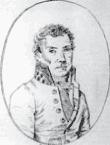
Born in Nantes, François Benoist was a pupil of Catel and Louis Adam at the Paris Conservatoire. In 1815, he won the Prix de Rome with his cantata Oenone. In 1819, he was appointed principal organist at the Chapelle royale and Professor of organ at the Paris Conservatoire, a post he held for 53 years. His pupils included Adolphe Adam, Alkan, Alexis Chauvet, César Franck, Dubois and Saint-Saëns… He can be ranked among the more influential founders of the Great French School of the 19th century.
In 1840, he became Premier Chef de chant at the Paris Opera. He contributed to the Revue et Gazette musicale de Paris.
His organ compositions include the 12 volumes of the Bibliothèque de l’organiste, published from 1840 to 1860, but also some Elevations, Communions, Verses, etc.
While the judgements imparted by 19th century artists are often severe, they deserve a few comments. J.-B. Laurens notes that there are many “who find this music cold” or who do not consider it as being specifically written for the organ. He adds however: “Well, even if all these criticisms are justified, the compositions of this artist will be no less worthy of our attention nor less nonouring for our country where so little high quality msic is published”.
As for Saint-Saëns, he praised the teacher and musician for his fine taste and “sound judgement” whose “every word carried weight and value”.
Composer Biography
Léon BOËLLMANN (1862-1897)
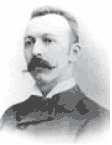
Léon Boëllmann was born in Ensisheim (Alsace), a small market-town close to Guebwiller and Mulhouse. He studied at the Ecole Niedermeyer from 1875 to 1881 where he took his examinations. He left the Ecole to be appointed Organiste du Chœur at Saint-Vincent-de-Paul in Paris, where he became titular of the Grand Orgue in 1887.
On his premature death at the age of thirty five, he left us with a large quantity of compositions from all musical genres, in particular for the organ and harmonium.
Two of the L. Boëllmann have kept a prominent place in the organists’ repertoire: the Suite gothique op. 25 (for Grand Orgue) and the Heures mystiques op. 29 and 30, a set of one hundred pieces for organ or harmonium, containing Entrées, Offertoires, Elévations, Communions and Sorties.
Composer Biography
Alexandre Pierre François BOËLY (1785-1858)
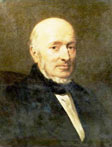
Born in Versailles, renowned pianist, writing numerous works for piano and strings, Boëly is principally remembered as an organist, first at Saint-Gervais, home of Couperin's organ, and then at Saint-Germain l'Auxerrois, the royal parish of the Louvre.
Full and essential (approximately 300 pieces), one part of his organ works was published during his lifetime, another part after his death. To this can be added pieces still in manuscript form.
The organ music of Boëly presents a number of different directions: the tradition of the 18th century French school (Offertories, Mass for the Christmas day, liturgical verses), more “germanic” pieces (Denizot canticles, chorales, fugues) and the pieces for Organ or Pedal Piano, before the generation of Schumann and Gounod, opening on the symphonic works by Franck.
In life, all the honours went to François Benoist, Grand prix de Rome and teacher at the Conservatoire, while Boëly had to be content with the praise of the connoisseurs. However, in 1902, Saint-Saëns wrote: “An artist cannot count on the support of his contemporaris; he can only attract later. The time has come to appreciate the works of this talented and worthy musician”.
Composer Biography
Antoine CALVIÈRE (1685-1755)
Calvière was a pupil of Isoré and organist in three parisian churches: Saint-Germain des Prés, Sainte-Marguerite and the Sainte-Chapelle. He also occupied posts at Notre-Dame and the Chapelle Royale.
He was a great admirer of François Couperin, composer of large motets as well as pieces for organ and harpsichord. The admiration was as much for his improvisational skills as for his written music. Unfortunately only one piece remains from his work, copied by Fétis as an illustration for his work “The Science of the organist” and kept in the library of the Brussels Conservatoire.
Composer Biography
Alexis CHAUVET (1837-1871)
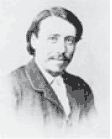
Alexis Chauvet was born in Marines, a small town in the French Vexin (to the northwest of Paris), where he started his career as an organist on the small Abbey organ. When he was 13, he entered the Paris Conservatoire where he studied the organ with François Benoist and composition with Ambroise Thomas.
In 1860, he was appointed organist at Saint-Thomas d’Aquin, first as accompanist, progressing to the Grand Orgue in 1861, then at Saint-Bernard de la Chapelle in 1863, Saint-Merri in 1866, and last at the Trinity Church where Cavaillé-Coll had just built the new Great Organ. He was both talented and gifted as a pedagogue.
He ranks among the most refined artists of his time and died in 1871, only having had the time to produce a modest number of compositions of a quality far superior to those of his times. He was considered as one of the most brilliant composer of organ music before his friend César Franck.
Biographie du Compositeur
Auguste FAUCHARD (1881-1957)
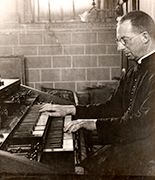
A student of the psallet of Laval (Mayenne), Auguste Fauchard played first the organ in the summer of 1892. Ordained a priest in 1903, he followed Louis Vierne's teaching in Paris from October 1903 to July 1904 while also auditing Alexandre Guilmant's organ class at the Conservatoire. He was then appointed vicar-organist at Notre-Dame de Mayenne until 1925, when he enrolled at the Schola Cantorum to study for two years with Louis Vierne and Vincent d'Indy, and André Marchal for improvisation. He obtained the gold diploma as an improvising organist from the upper course of the Schola Cantorum.
Appointed organist of Laval Cathedral, he spread his art throughout France. In 1953, he was made a knight in the order of the Legion of Honour. He leaves an important work that reveals a powerful personality.
Composer Biography
Sigismond NEUKOMM (1778-1858)
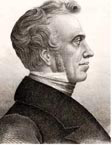
Organist, conductor and composer. He was a pupil of Michel Haydn and later of Joseh Haydn. He arrived in Paris in 1809 where he met Monsigny, Gossec, Grétry, Cherubini. In 1814, as pianist to Prince de Talleyrand, he attended the Congress of Vienna. In 1816, the Prince of Luxembourg took him to Rio de Janeiro where he made the music of Haydn and Mozart in particular known in South America. Back Paris in 1821, his principal home for the rest of his life, he has been travelling through the Europe, giving organ recitals in the major places.
His numerous compositions show a classical tradition, from opera to music for reed organ, from lied to psalm and Haydn’s works arrangements…
Some members of his family were living in France: his brother, Anton, who was appointed at the Great Organ of the Saint-Ouen Abbey in Rouen, his sister, Elisabeth, a famous soprano, and his nephew Edmond, journalist at the Revue et Gazette musicale de Paris, who left in 1899 his uncle musical library to the Conservatoire library.
Composer Biography
Louis NIEDERMEYER (1802-1861)
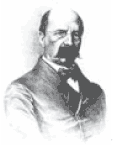
Born in Switherland, Niedermeyer received his firt music lessons from his father. He then studied in Vienna with Moscheles (piano) and Förster (composition). He went to Naples where he studied with Zingarelli and met Rossini. Apart from a period in Brussels, he lived from 1823 in Paris.
After the failure of his last opera, he devoted himsel to sacred compositions and reopened the school of church music that Choron had founded in 1819. The work of the Ecole Niedermeyer aimed to turn out church musicians with a comprehensive knowledge of both Gregorian and the works of the masters of vocal polyphony. The prestigious teachers who devoted themselves to this ambitious task included Saint-Saëns, Dietsch, Carlini, Clément Loret... The more remarkable pupils included Eugène Gigout, Albert Périlhou, Gabriel Fauré, André Messager and Gustave Lefèbre as well as numerous provincial musicians.
The name of Niedermeyer is still associated with the name of the school he founded in 1853 and which was devoted to raising the quality sacred music based on the great classical masters such as Palestrina and J.S. Bach.
Composer Biography
Albert RIBOLLET (1884-1963)
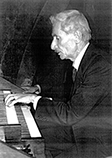
Albert Ribollet entered in 1900 the Conservatoire in Paris. For ten years, he studied with the great teachers of the day: the organ with Ch.-M. Widor, L. Vierne and A. Guilmant, and composition with Gédalge and Xavier Leroux. In 1906 he was awarded a First Prize in Harmony and in 1908 a First Prize in Counterpoint. He started as organist of Notre-Dame-de-Passy and at the same time assumed the function of Maître de Chapelle at Notre-Dame-du-Rosaire. He was appointed in 1913 organist at the Casino municipal in Nice, then a short time later organist of the Cathedral Sainte-Réparate in Nice.
Mobilized in 1914, he was woounded and had to have his right leg amputated. After long months of rehabilitation, he resumed his post as organist of the Cathedral. In 1948, he was appointed Director of the Conservatoire de Musique in Nice, where he remained in office until 1962, the date on which Pierre Cochereau succeded him.
He was both a prestigious improviser and a prolific composer: Symphonies, Symphonic poems, an Opéra-Comique, chamber music, Pieces for piano, Vocal music including choral a cappella, Pieces for organ, organ and orchestra, Masses for choir and organ, etc. These works were for the most part written in Nice and the greater part of which remain unpublished to this day.
Biographie du Compositeur
Daniel ROTH (1942-)

Daniel Roth was born in Mulhouse (Haut-Rhin) on 31 October, 1942. His admiration for Albert Schweitzer led him to study piano, organ and writing at the conservatory in his hometown. He continued them at the CNSM in Paris, where he won five first prizes: harmony, counterpoint and fugue, organ, interpretation and improvisation, accompaniment. He studied early music with Marie-Claire Alain. He has won prestigious competitions, including Chartres (1st prize in interpretation and improvisation, 1971).
In 1963, deputy of the great organ of the Basilica of the Sacré-Cœur de Montmartre, he held it from 1973 to 1985, when he became titular of the great organ of Saint-Sulpice.
He teaches organ and harmony at the Conservatoire de Marseille and then organ at the Catholic University of America in Washington D.C, in Strasbourg, Saarbrücken, and succeeds Helmut Walcha and Edgar Krapp at the Musikhochschule Frankfurt am Main (1995-2007), while pursuing an international career: recitals, inauguration of numerous instruments, solo concerts with major orchestras, masterclasses and conferences (United States, Japan, Australia, Europe), radio and television recordings, competition panels.
As a composer, he has written works for solo organ, organ and flute, a cappella choir, choir and organ, for soloists, choir and organ, and a triptych for piano, organ and orchestra Licht im Dunkel. In 1999, he received the Florent Schmitt Prize for Composition and was awarded the European Church Music Prize at the Schwäbisch Gmünd Festival in 2006.
Daniel Roth's modal language is in the tradition of Duruflé, and we can sometimes perceive in his writing the influence of musicians such as Honegger, Ravel, Darius Milhaud in the use of polymodality.
He is a member of the National Commission of Historic Monuments and a knight in the orders of the Legion of Honour and the Arts and Letters.
Biographie du Compositeur
Jean STEINMETZ (1930-2005)
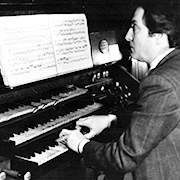
Born on June 19, 1930 in Paris, Jean Steinmetz began his musical studies with his father, then at the Schola Cantorum and finally at the Ecole César Franck while perfecting his organ skills with Rolande Falcinelli.
In 1955, he was appointed choir organist and choirmaster of St. Louis-en-L'Île, Paris, where he also replaced Jean Arnault, organist of the great Merklin organ. In 1971, he succeeded Guy Lambert, organist and choirmaster of Saint-Laurent, Paris, for whom he had been deputy since 1964, and alerted the authorities concerned to the poor condition of the instrument. After long negotiations, the organ was restored by the organ maker Renaud and inaugurated on February 14, 1995 with the Carillon for Great Organ.
Shortly afterwards, J. Steinmetz retired and held the keyboards of the great Stoltz organ of the Ste Marguerite church until his death.
Composer Biography
René VIERNE (1878-1918)
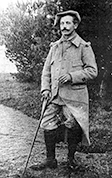
Born in Lille, René Vierne was the youngest brother of the organist of Notre-Dame, Louis Vierne. His mother sent him to a Catholic school in Versailles in 1889, it becomed evident that he was not destined for the priesthood but his intention was to make music his life’s work. He started with his elder brother, then attended lessons in the class of Alexandre Guilmant at the Paris Conservatoire where he won a firts prize in 1906. While a student at the Conservatoire, he also worked in a professional capacity, being organist at the Dominican Convent, then at Notre-Dame des Champs.
When war was declared, he was called up and left for the battle front in 1914. He was killed on 29 May 1918 by an exploding shell.
He left us a small but diversified work: polyphonic pieces, organ or harmonium pieces, a Méthode pour orgue-harmonium promoting the “theory” of Nicolas-Jacques Lemmens, a technique passed on by Charles-Marie Widor: legato-playing, finger-substitution, using the heels in pedal-playing, etc.
“In his delectable improvisations he poured out his poetic soul, mystical without any trace of affectation”, commented Louis Vierne, faithfully summing up summary René Vierne's style, in which one can find the combinated influences of César Franck and his elder brother Louis.
No manuscript of René Vierne has come down to us. His music was printed by many different publishers; collating the various sources has been made difficult by the fact that they are widely dispersed.
René Vierne left polyphonic compositions, organ and harmonium works and a Méthode d’harmonium promoting the “thery” of Nicolas-Jacques Lemmens. “In his delectable improvisations, he poured out his oetic soul, mystical without any trace of affectation”, commented Louis Vierne, faithfully summing up summary René Vierne’s style, in which one can find the combined influences of César Franck and his elder brother Louis.
